This is the third of three features that I have done this pre-season regarding an analysis of fantasy Wide Receivers.
In the first feature, I looked at the empirical receiving data from 2022 (in terms of targets, receptions and fantasy points) to help build a model (or at least a starting point) for ranking the fantasy wide receivers headed into 2023. In the second featured I analyzed Sophomore Wide Receivers (from the Class of 2022).
Today I will look closely at what I call the QB-to-WR Index. This index attempts to build a model whereby we can tie a WR's predicted performance to that of his corresponding QB.
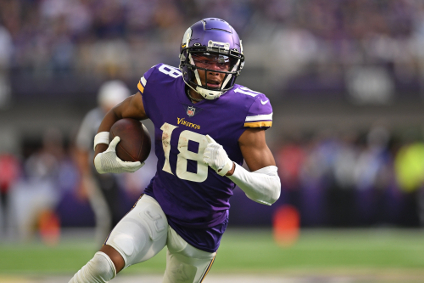
More specifically, like the first feature, this feature is built around a number of top-40 charts. My goal is to use the data represented in these tables to begin a guided tour that will hopefully get us to our destination: an initial ranking of fantasy wide receivers based on their own data elements from last year as well as data associated with the QBs who will be tossing them the ball in 2023.
The charts include the final 2022 rankings of wide receivers in the following categories: WR Fantasy Points (based only on receiving factors), WR Fantasy Points Per Target (again, based only on receiving factors), WR Team Share, QB Fantasy Points (based only on passing factors), and QB Fantasy Points Per Pass Attempt (again, based only on passing factors).
Note that the tables below reference the 2022 team for which each player played last season.
Lets start by simply looking at the wide receivers who scored the most points in fantasy in 2022. Note that the point totals listed below represent both standard scoring (1.0 point for each yard rushing/receiving and 6 points per touchdown).
WR Fantasy Points - Receptions Only
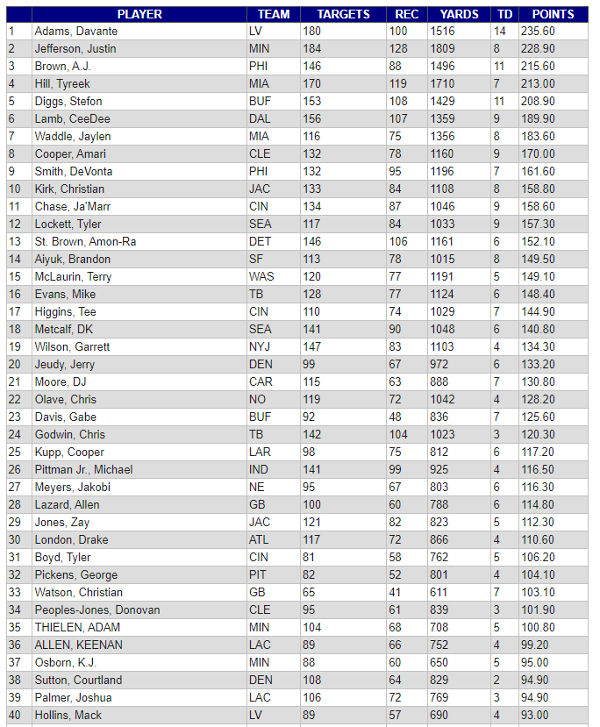
Why This May Be Helpful: Well, this is pretty obvious, as it lays out the top fantasy performers at the WR position in 2022. The caveat is that I have removed fantasy production that did not come from the passing game. That is because, stats outside of the passing game would not factor into the QB-WR Index I am looking at here. Hence, guys like Deebo Samuel who saw a great deal of production in the running game take a hit.
Aside from the usual studs, there were a number of surprise players such as Christian Kirk, Garrett Wilson and Chris Olave who all posted start-worthy numbers -- that is, finished as at worst a WR2 in 12-team leagues -- but were largely overlooked last year in fantasy drafts. Speaking of which... note that Gabe Davis did indeed finish as WR23 in standard formats, making him a genuine fantasy WR2 despite the perception that he was a "bust" in 2022.
WR Fantasy Points Per Target
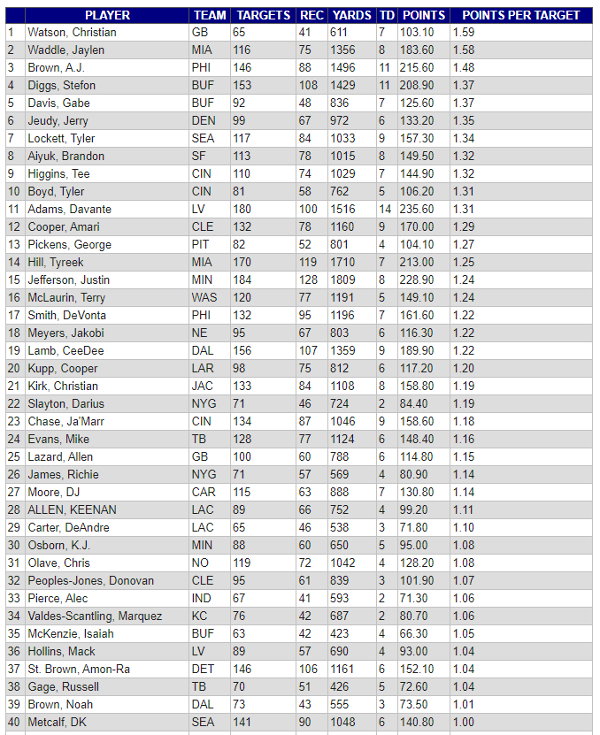
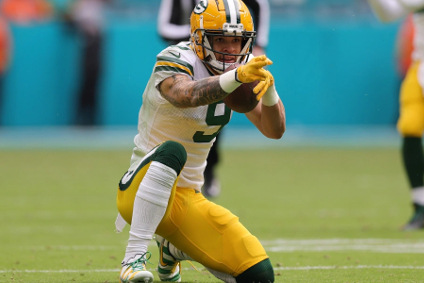
Why This May Be Helpful:The Points Per Target value was rounded to two digits to the right of the decimal, but all sorting was performed prior to the rounding -- and no two players had an identical value prior to the rounding. That is, there were no ties despite the identical values listed above -- and the players are all listed in the correct order.
After clarifying all that, I must say that this is one of my favorite statistics when looking at fantasy wide receivers as it truly measures which players made the most (fantasy points) of the opportunities presented to them (targets). The key to identifying fantasy relevance is to identify which players appear on this Fantasy Points Per Target chart as well as the Total Targets chart. This will present you with the list of players who operated at a high fantasy level due to both volume and production.
But Be Careful: This stat can be heavily influenced by a couple of big plays if the receiver has an inordinately small sample size. That would be the case here with Christian Watson, although he did receive 65 targets, which is enough to make us take notice -- but also probably not enough to make an assertion that he deserved to be ranked as a fantasy WR2, let alone fantasy WR1. Note that in my first piece, when we made the same evaluation, I intentionally required a minimum of 75 targets to better eliminate the sample size concern.
WR Team Share
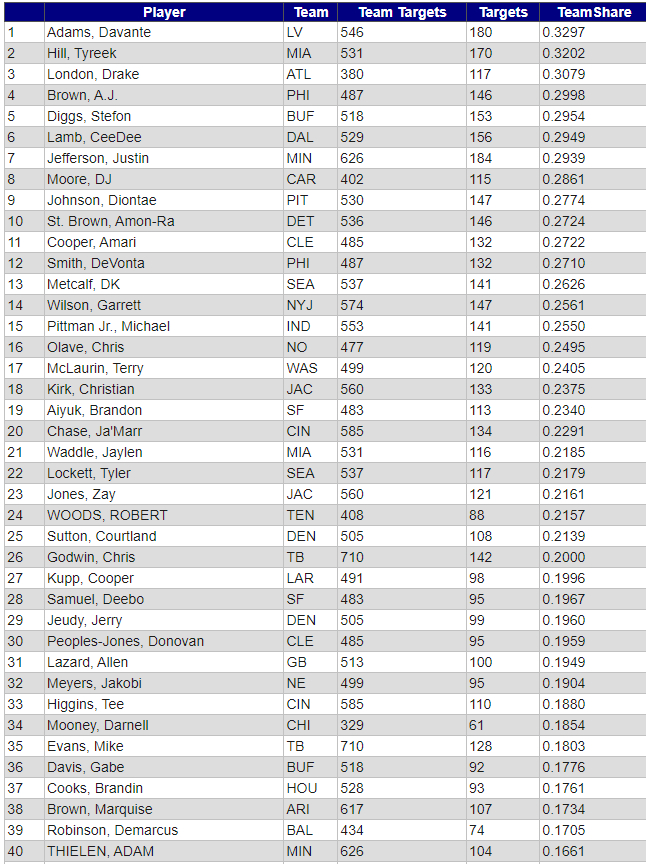
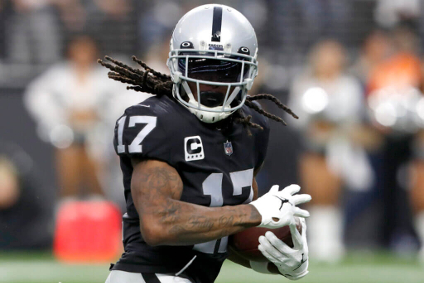
Why This May Be Helpful:What this does is emphasize not only which receivers were the favorite targets of their respective teams -- but which ones became the apple's eye of their quarterback.
It is not surprising to see at the top of the list Adams and Hill. What is a bit surprising in #3, Drake London who led Atlanta with over 30% of the team's targets.
But Be Careful:I suppose the value from a fantasy perspective here lies in identifying those teams which may evolve into a more pass-friendly offense in 2023 or whose QB situation may be better. (See below)
Conversely, be careful to look closely at teams that added immediate reinforcements -- or players who have moved on. Keep a close eye on free agency to see what moves may have the greatest impact.
QB Fantasy Points - Passing
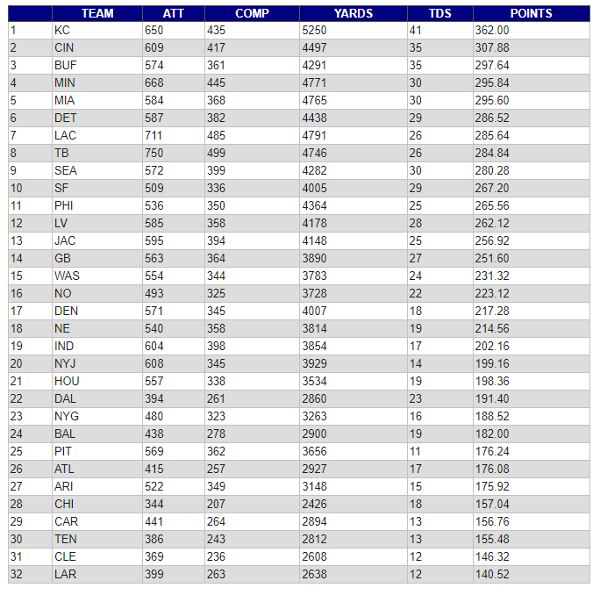
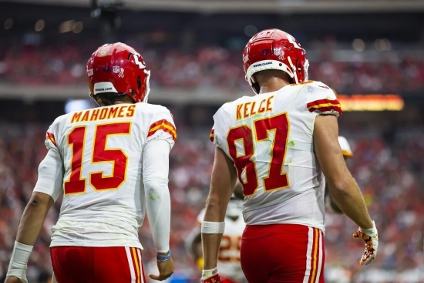
Why This May Be Helpful:
Now, instead of looking at each WR's stats, we are looking at each team's passing production as a whole. This gives us an understanding of which offenses were more pass-centric -- and which ones provided the best opportunity for fantasy production. It makes sense then that our top three were KC, Cinci and Buffalo with stud QBs Patrick Mahomes, Joe Burrow and Josh Allen leading the way respectively. Note that the underrated Kirk Cousins comes in at #4 with the Viking offense, which maybe should not be that great of surprise given that he has Justin Jefferson to throw the ball to.
But Be Careful: First, this metric looks at team passing stats rather than just individual QB production -- and this production is based only on 2022 numbers. So, for example, we see that Tampa Bay ranked in the top 10 in fantasy passing last season. However, Tom Brady has now retired, which likely means a significant drop-off in 2023, which undoubtedly affects Mike Evans and Chris Godwin.
Note also that this production is passing only. I do that because WRs are only impacted by a QB's passing stats -- not his rushing stats. That explains why J. Hurts, a top 3 fantasy QB in almost every format in 2022, represents a Philly team whose overall passing offense comes in at only 11th (which is still respectable).
QB Fantasy Points Per Pass Attempt
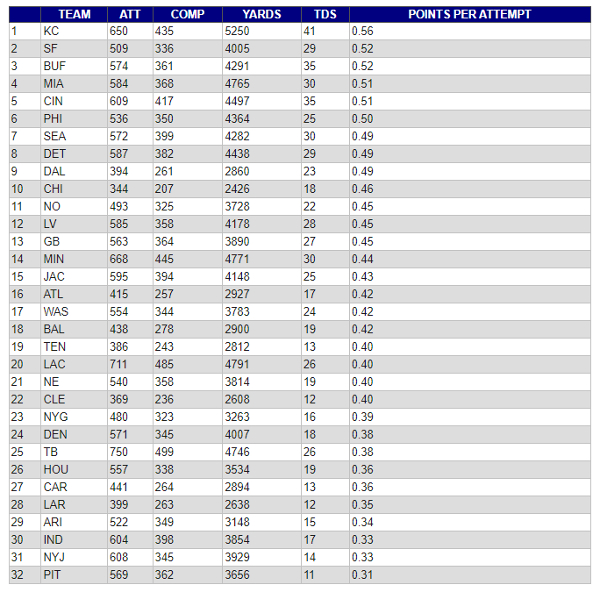
Why This May Be Helpful: Our first passing chart was based on production and not coincidentally volume. This one is more based on efficiency. That is QUALITY over QUANTITY. So, for example, we see that the 49ers with their highly effective and QB-friendly offense ranked 2nd on our list here, even though their balanced approach to offense assured that they were not among the league leaders in passing volume. Meanwhile, note how amazing it is that the Chiefs rank #1 on both charts -- that just goes to show how special the Andy Reid-Patrick Mahomes passing offense is in Kansas City. The same came be said of Buffalo, where Josh Allen's Bills ranked #3 on both charts, and to a lesser extent Miami. If is worth wondering where Miami's pass offense would rank in terms of overall production and on a per pass attempt basis if Tua could stay upright all season.
But Be Careful:Much like the Points Per Target matrix, which is an effective measurement for determining quality, there are drawbacks. Given that the passing metric is season-long and team-wide, I don't think that sample size is as much of an issue as it is when we look at WR production on a per target basis. Still, volume MUST be taken into consideration. In fantasy you will not win based on style points or who-did-what on a per play basis. You win based on production. So it makes little sense to use this chart outside of the the context of the first chart as well. In fact, that is exactly how I would use it in helping to identify the receivers who are in the best position to succeed thanks to their quality at QB.
Also, simply because a team has an elite QB with a highly productive passing game, that does not mean that every receiver on the team is a serious fantasy option. The obvious example of this is Kansas City. A very strong argument could be made that Patrick Mahomes is the best QB in the league. The charts here confirm this. However, the target share is such that the offense flows through Travis Kelce with the various receivers receiving small-time shares. Hence I could not rank any KC wide receiver as a WR1 or even WR2 in fantasy.
Finally, the QB-WR Index
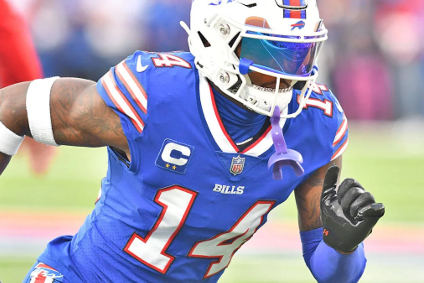 1. Stefon Diggs
1. Stefon Diggs
2. AJ Brown
3. Tyreek Hill
4. DaVante Adams
5. Jaylen Waddle
6. Justin Jefferson
7. Brandon Aiyuk
8. DaVonte Smith
9. Tyler Lockett
10. JaMarr Chase
11. CeeDee Lamb
12. Tee Higgins
13. Gabriel Davis
14. AmonRa St. Brown
15. Christian Kirk
16. Tyler McLaurin
17. Amari Cooper
18. DK Mekalf
19. DJ Moore
20. Michael Pittman Jr.
21. Jerry Jeudy
22. Chris Olave
23. Tyler Boyd
24. Mike Evans
25. Jakobi Myers
26. Drake London
27. Christian Watson
28. Richie James
29. Zay Jones
30. Cooper Kupp
31. George Wilson
32. KJ Osborn
33. Allen Lazard
34. Chris Godwin
35. Marquez Valdes-Scantling
36. Mack Hollins
37. George Pickins
38. Keenan Allen
39. Donovan Peoples-Jones
40. Brandin Cooks
41. Courtland Sutton
42. Darius Slayton
43. Joshua Plamer
44. Diontae Johnson
45. Adam Thielen
46. DeAndre Carter
47. Robert Woods
48. Noah Brown
49. Darnell Mooney
50. Marquise Brown
Why This May Be Helpful:This combined series of metrics takes into account all of the following: WR Volume, WR productivity and corresponding passer effectiveness. While it does not serve as a true ranking of fantasy WRs, it does provide a decent ballpark and provides an additional perspective when trying to decide between two WRs that you have ranked closely together. For example, this will help us identify receivers who have moved on from a team that was less prolific in the passing game to a more pass-friendly team (and vice versa).
Of interest is that in our first segment of purely WR metrics, Steffon Diggs ranked #1 -- and he ranks #1 here as well. Maybe there is something to that. It stands to reason that Diggs is heavily targeted in the 3rd most prolific passing offense with the 3rd most efficient QB and is himself highly efficient on a per-target basis. I am not saying that he deserves to be drafted head of the likes of Jefferson and Chase, but a strong argument can be made that he warrants consideration in the same ballpark.
Another thing I can't help but notice is how closely Miami receivers Hill and Waddle are ranked. Note that Hill currently has an ADP of around 7 in typical leagues, whereas Waddle's is around 24. While I agree that Hill deserves to be ranked higher, perhaps from a VALUE perspective it makes sense to pass on Hill, take a RB1 there -- and wait on Waddle in the next round?
But Be Careful:Like I said, it does NOT represent a true WR ranking. For example, in most drafts you will see Justin Jefferson or JaMarr Chase as the top two receivers coming off the board for good reason. Yet, in the QB-WR Index they rank 6th and 10th respectively. Why is that? Well, as productive as Jefferson was, his 8 TDs were a bit ho-hum, which impacts his metrics. Meanwhile, Chase missed a few games with injuries last season, which explains why he dropped in our metrics as well.
Another thing to be cautious of is that this exercise relies solely on 2022 production. So guys who had off-years or missed the season entirely (D. Hopkins and OBJ, for example) are missing from these metrics. Likewise, there is no accounting for rookie players either.